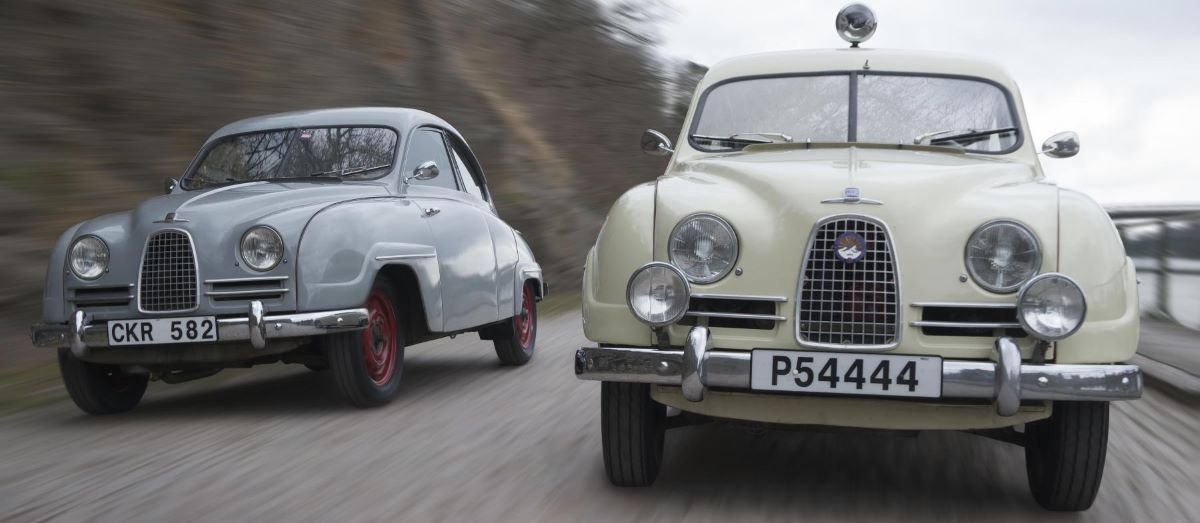
Saab is celebrating its first major victory in international motor sport by showing a replica of the Saab 93 saloon which won the Finnish 1,000 Lakes Rally in 1957.
With Erik ‘Mr Saab’ Carlsson at the wheel, this historic victory brought international recognition for the Saab brand. It also presaged back-to-back Monte Carlo and a hat-trick of RAC Rally victories that Carlsson would achieve in the early 1960s.
Powered by a 748 cc, three cylinder engine, but weighing only 810 kilos, the Saab 93’s agile handling enabled it to embarrass far more powerful, larger cars. It established a winning ‘David beats Goliath’ formula that was to be a cornerstone of Saab’s rallying success.
The Saab 93 is now about to see competition action again. The car on show – from Saab’s car museum in Trollhättan, Sweden – will be driven by Spyker Cars CEO Victor Muller on Italy’s historic Mille Miglia road race in May. He will be joined by Saab Automobile CEO Jan Åke Jonsson at the wheel of another Saab 93. Both will be following, at a more leisurely pace, in the wheel tracks of the 1000 Lakes winner, which won its class on the same event back in 1957.
Both cars will follow the tracks of the original Mille Miglia 750 cc class winners. This time it will however take place at a more leisurely pace, than when Charlie Lohmander and Harald Kronegård, drove their Saab 93 in 1957.
“Unique cars like the 93 are a key part of the Saab brand’s wonderful heritage,” said Victor Muller. “I shall enjoy driving it and being able to share in some of Saab’s history.”
Between 1955 and 1960, 52.731 Saab 93s were built at Trollhättan. Its frontal styling introduced a new face for Saab, carried forward by the 96 saloon and 95 station wagon which stayed in production until 1980.
Powered by a 45 hp, 748 cc, three-cylinder engine, but weighing only 810 kilos, the Saab 93’s agile handling and good aerodynamics enabled it to embarrass far more powerful, larger cars. “Saab’s early success on this event is part of our rich heritage,” said Jan Åke Jonsson. “We’re looking forward to competing once again with the Saab 93, although we won’t be driving it quite so fast.”
This year’s event, from 6 – 8 May, is Victor Muller’s tenth Mille Miglia. “The 93 is unlike any other car I’ve entered, which is hardly surprising as it’s a Saab,” he said. “Jan Åke and I will enjoy the event and we’re looking forward to a little friendly rivalry between team-mates. It certainly won’t be as intense as the competition between Eklund and Blomqvist when they were rallying with Saabs in the late 70s.”
Saab’s 1957 Mille Miglia success was followed by Erik ‘Mr Saab’ Carlsson’s overall victory on the Finnish 1000 Lakes Rally later the same year, both results bringing early international recognition for the Saab brand. Carlsson would go on to achieve back-to-back Monte Carlo wins and a hat-trick of RAC Rally victories in the early 60s.
Between 1955 and 1960, 52,731 Saab 93s were built at Trollhättan, where Saabs are still produced today. Its frontal styling introduced a new face for Saab, carried forward by the 96 saloon and 95 station wagon which stayed in production until 1980.
Technical data: Saab 93, 1957, Group 2 competition regulations:
| Engine: | 3-cylinder, 2-stroke engine, 748cc Solex 40 AI carburrettor |
| Power: | 55 hp/ DIN / 5.500 rpm (Standard 33 hp/ DIN / 4200 rpm) |
| Transmission: | Front-wheel drive, 3/4-spd manual gearbox, freewheel,steering column shift |
| Body/chassis: Unitary. | Front suspension: double A-arms, coil springs, anti-roll bar |
| Rear suspension: rigid, U-shaped rear axle, coil springs. Drum brakes all-round | |
| Dimensions (mm): | Length 4.010, Width 1.570, Height 1450 mm, |
| Wheelbase | 2.488 |
| Track front/ rear | 1,220 |
| Weight: | 810 kg |
| Performance: | 0-60 km/h: 13 secs. Top speed: 93mph |
Saab Svenska Aeroplan Aktiebolaget (Swedish Aircraft Company) – was founded in 1937 as an aircraft manufacturer and revealed its first prototype passenger car 10 years later after the formation of the Saab Car Division. In 1990, Saab Automobile AB was created as a separate company, jointly owned by the Saab Scania Group and General Motors, and became a wholly-owned GM subsidiary in 2000. In February 2010, Spyker Cars N.V. of the Netherlands, acquired the company from GM as an independently-run business.
Saab cars reflect the brand’s unique Scandinavian design ethic, which is fused with its aircraft engineering heritage. The company is a global premium car maker with a distinguished history of innovation. It is recognised for its pioneering role in turbocharging, as well as occupant safety and the introduction of flex-fuel technology through Saab BioPower. Saab Automobile AB currently employs about 3,400 staff in Sweden, where it operates world-class production and technical development facilities at its headquarters in Trollhättan, 70 km north of Gothenburg.

You must be logged in to post a comment.